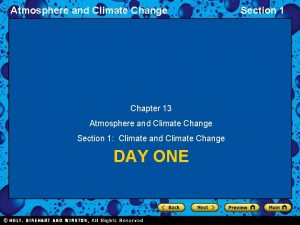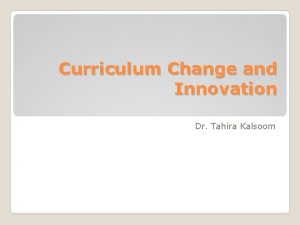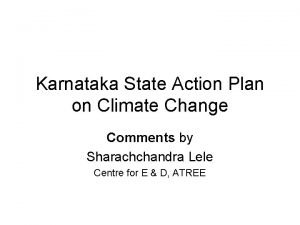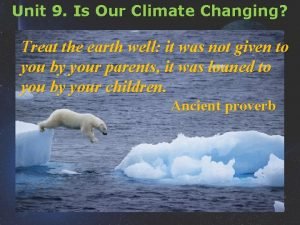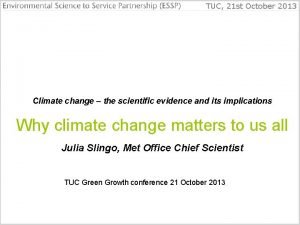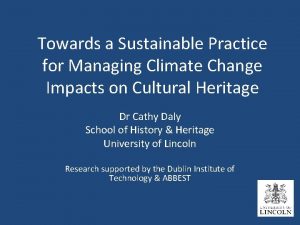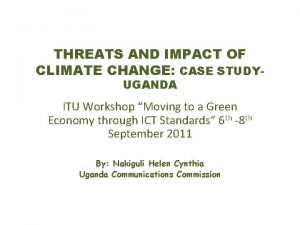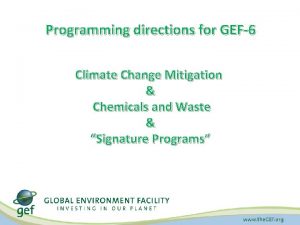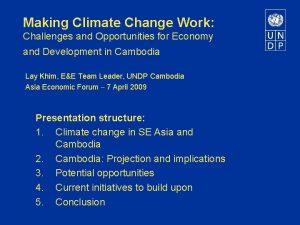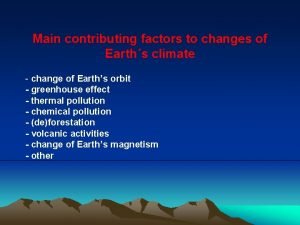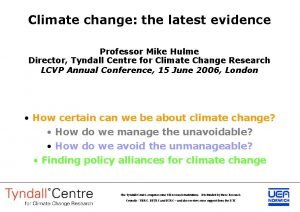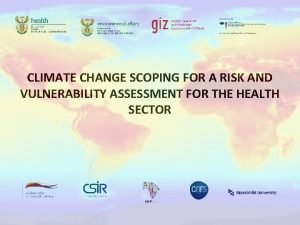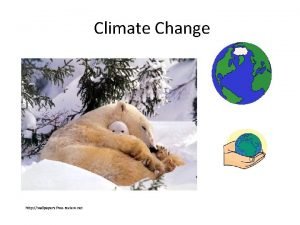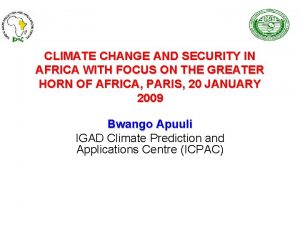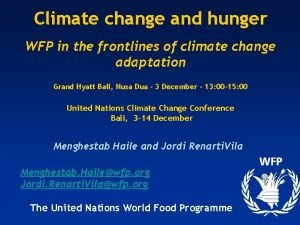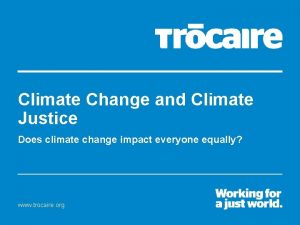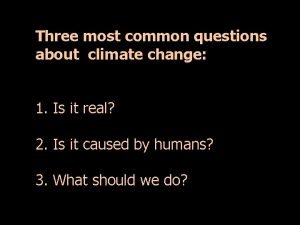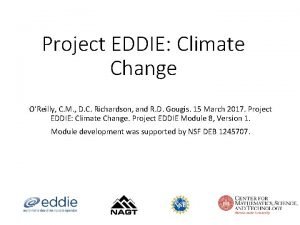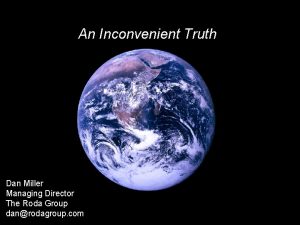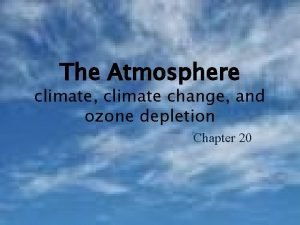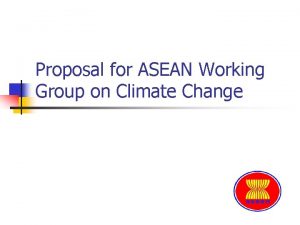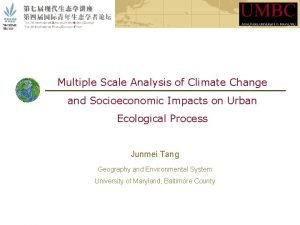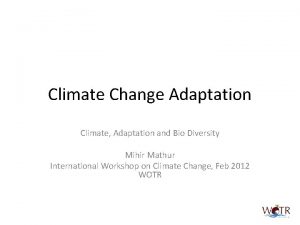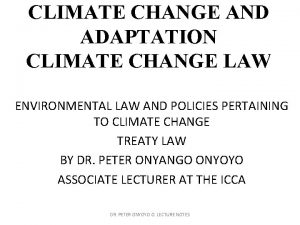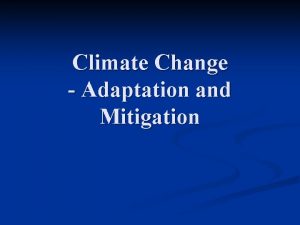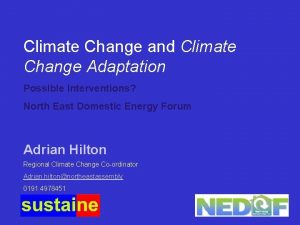Agroecology and Climate Change Necessary Strategies for Adaptation





























![Summary: Biophysical Service Equivocal Weak Effect Soil Quality [SOM, physical, biological characteristics, erosion reduction] Summary: Biophysical Service Equivocal Weak Effect Soil Quality [SOM, physical, biological characteristics, erosion reduction]](https://slidetodoc.com/presentation_image_h2/1b1e41c3e17e476d338c5d1fd6dabe87/image-30.jpg)







- Slides: 37

Agroecology and Climate Change: Necessary Strategies for Adaptation and Mitigation Albie Miles, Ph. D. Assistant Professor Sustainable Community Food Systems University of Hawai‘i, West O‘ahu albie@hawaii. edu

Outline: 1. Climate Change and Agriculture: Anticipated impacts and the contribution of agriculture to global climate change; 2. Biologically Diversified Farming Systems: Key Findings on Ecosystem Services and Productivity; 3. Implications for Climate Change Adaptation and Mitigation 4. Political Context

Tend in Atmospheric CO 2 Concentrations: Current (mean): 403. 26 ppm. Target: 350 ppm NOAA 2015: http: //www. esrl. noaa. gov/gmd/ccgg/trends/

Carbon Dioxide Concentrations Source: 350. org

United Nations Intergovernmental Panel on Climate Change Report (2014) Key Findings of the 2014 UN IPCC Report: • Very strong evidence that climate change is taking place on land sea globally; • Greenhouse gases have driven up global temperatures and extreme weather; • Climate change threatens global food supply by threatening sources of food and water due to extreme weather events; • Climate change is already impacting food production and food price volatility. UN IPCC (2014): http: //www. ipcc. ch/

Implications of Study in the Context of the United Nations Intergovernmental Panel on Climate Change Report (2014): Key findings of the 2014 UN IPCC Report: • “…if the world does nothing to mitigate emissions of greenhouse gases, and the extent of climate change continues to increase, then the very social stability of human systems could be at stake. ” - Rajendra Pachauri, Chair of the IPCC • Calls for immediate action for adaption and mitigation. UN IPCC (2014): http: //www. ipcc. ch/

Global Greenhouse Gas Emissions by Sector Agriculture and the food system is responsible for an estimated 40% of global GHG emissions – the largest driver of climate change. Source: UN IPCC (2007); Foley 2010, 2012.

Development and Deployment of “Green Revolution” Technologies: 1940 -Present • High-yielding crop varieties • Concentrated mineral fertilizers: nitrogen and phosphorus • Synthetic chemical pesticides • Irrigation water • Mechanization Perkins 1990; Evenson and Gollin 2003; Vandermeer 2011; Pingali 2012.

World food production - measured as the sum of cereals, coarse grains and root crops - almost doubled from 1961 to 1996. Tilman D PNAS 1999; 96: 5995 -6000 © 1999 by National Academy of Sciences

The relationship between annual global *food production and agricultural inputs (FAO data). *cereals, coarse grains, root crops Tilman D PNAS 1999; 96: 5995 -6000 © 1999 by National Academy of Sciences

The relationship between annual global food production and agricultural inputs: high yielding modern varieties © 1999 by National Academy of Sciences Evenson, R. E. and Gollin, D. 2003. Assessing the impact of the Green Revolution, 1960 to 2000. Science 300(5620): 758 -762.

The loss of agro-biodiversity Thrupp, L. A. (2000). Linking agricultural biodiversity and food security: the valuable role of agrobiodiversity for sustainable agriculture. International affairs, 76(2), 283 -297.

Ecosystem Services and Disservices from Agriculture Crop monocultures Benton et al. 2003, Tscharntke et al. 2005, De Fries et 85 al. 2010

Monoculture: Agro-ecosystem processes • concentration of plant host resources for specialist herbivores; • loss of habitat and decreased diversity and abundance of beneficial arthropods; • decreased biological control of pests; • increase density of specialized herbivore pests; • increased crop loss or damage. Barbosa 1998; Altier 1995, 1999; Matson et al. 1999; New 2005; Wilkonson and Landis 2005; Zhang et al. 2007; Letourneau et al 2011

Application of concentrated synthetic nitrogen and phosphorus fertilizer

Ecological consequences of the intensive use of mineral fertilizers: nitrous oxide (N 20) emissions Increased fertilizer use over the past 50 years is responsible for a dramatic rise in atmospheric nitrous oxide, a potent (300 x) greenhouse gas (Park et al 2012). Park et al. 2012. Trends and seasonal cycles in the isotopic composition of nitrous oxide since 1940. Nature Geoscience 5, 261– 265 (2012) doi: 10. 1038/ngeo 1421

Synthetic Chemical Fertilizer: Agro-ecosystem processes Changes to crop nutrient status and susceptibility to pests and pathogens Altieri and Nicholls 2003; Zehnder et al 2007; Garratt, M. P. D. , D. J. Wright, and S. R. Leather. "The effects of farming system and fertilisers on pests and natural enemies: a synthesis of current research. " Agriculture, Ecosystems & Environment 141. 3 (2011): 261 -270.

Synthetic Chemical Fertilizer and Intensive Tillage: Agro-ecosystem processes Soil erosion and eutrophication Tilman et al. 2002; Magdoff and Weil 2004

Agroecological Impacts of Agricultural Intensification Soil erosion, nutrient loss and the eutrophication of the world’s marine ecosystems Source: Diaz, R. J. and Rosenberg, R. 2008. Spreading dead zones and consequences for marine ecosystems. Science 321(5891): 926 -929.

Synthetic chemical pest and weed control

Chemical Pest And Weed Control: Agro-ecosystem processes Genetic Resistance, Impacts to Non-target Organisms and Pest Resurgence Vandermeer 2011

Intensive tillage and bare soil fallow periods

Synthetic Chemical Fertilizer and Intensive Tillage: Agro-ecosystem processes Degradation of soil quality Magdoff and Harold van Es 2000; Magdoff and Weil 2004.

Agroecology: The application of ecological principles to the design and management of sustainable agroecosystesms Altieri 1995; Altieri and Nicholls 1999; Barbosa 1998; Gliessman 2014

Case Study in Agroecology: The ‘push-pull’ system in East Africa Altieri 1989; Khan et al. 2011; Cook et al. 2007

Comparing Biologically Diversified with Conventional Farming Systems: what is known about the tradeoffs among crop productivity and ecosystem services? Kremen, C. , & Miles, A. (2012). Ecosystem services in biologically diversified versus conventional farming systems: benefits, externalities, and trade-offs. Ecology and Society, 17(4), 40.

Objectives & Scope of Paper Rationale: To provide a global quantitative summary of a representative scientific literature measuring differences in the provisioning of important ecosystem services (ES) to and from biologically diversified as compared to conventionally managed and biologically simplified farming systems. Ecosystem services assessed in the study: – – – – – Biodiversity Soil quality enhancement Water use efficiency Control of weeds, diseases and arthropod pests Pollination services Carbon sequestration Energy use Global warming potential Resistance and resilience to severe weather conditions Food productivity/yield


Classification of Findings on Diversified Farming Systems and Ecosystem Services • Summary Table: – ‘Strong Effect’: > 25% change and (p<0. 05) – ‘Weak Effect’: < 25% change, OR weak significance (p>0. 05) – ‘Equivocal’: data indicate no clear trend at present resulting from too few studies conducted to clearly determine trend in data. • Findings key: – Positive Findings (X) = diversified farming practices provided greater benefits for the service or indicator than conventional practices. – Negative Findings (X) = diversified farming practices provided fewer benefits for the service or indicator than conventional practices.
![Summary Biophysical Service Equivocal Weak Effect Soil Quality SOM physical biological characteristics erosion reduction Summary: Biophysical Service Equivocal Weak Effect Soil Quality [SOM, physical, biological characteristics, erosion reduction]](https://slidetodoc.com/presentation_image_h2/1b1e41c3e17e476d338c5d1fd6dabe87/image-30.jpg)
Summary: Biophysical Service Equivocal Weak Effect Soil Quality [SOM, physical, biological characteristics, erosion reduction] x N leaching [org-conv comparison] P leaching [org-conv comparison] Strong Effect x x N + P leaching [riparian buffer] x Water use efficiency x Strong Effect: >25% change Weak Effect: < 25% or weak significance Equivocal: NS or too few studies conducted

Summary: Biotic interactions Service Equivocal Weak Effect Strong Effect Biodiversity [abundance, richness of arthropods, plants & birds] x Control of Weeds x Control of Plant Pathogens - aerial - soil x Control of Arthropod Pests -local scale -landscape scale Pollination Services Strong Effect: >25% change Weak Effect: < 25% or weak significance Equivocal: NS or too few studies conducted x x

Summary: Climate change adaptation (A) & mitigation (M) Service Equivocal Weak Effect Strong Effect Carbon sequestration (M) x Energy use (M) x Global warming potential (M) x Resilience to drought (A) x Resistance to hurricane (A) x Strong Effect: >25% change Weak Effect: < 25% or weak significance Equivocal: NS or too few studies conducted

Yield/Productivity Service Yield Developed country (org-conv) Developing country (DFS – “resource poor”) Equivocal Weak Effect x Strong Effect: >25% change Weak Effect: < 25% or weak significance Equivocal: NS or too few studies conducted Ponisio, L. C. , M'Gonigle, L. K. , Mace, K. C. , Palomino, J. , de Valpine, P. , & Kremen, C. (2015). Diversification practices reduce organic to conventional yield gap. Proceedings of the Royal Society of London B: Biological Sciences, 282(1799), 20141396.

Conclusions Substantial evidence of significant advantages to ecologically based and BDFS for the following ecosystem services: 1. 2. 3. 4. 5. 6. 7. biodiversity conservation; control of arthropod pests, weeds and diseases; pollination services; soil quality enhancement and maintenance; water use efficiency, carbon sequestration; Increased energy use efficiency; Increased resistance and resilience of farming systems to extreme weather events. 8. Reduced nutrient losses (N)

Conclusions Organic farming systems and agroecology receive 1. 68 – 4. 1% of total USDA Research, Education & Extension funding (Carlisle & Miles 2013; Delong et al. in preparation)

Conclusions With significant public investment in agro-ecological research, education and extension, society would realize even greater social and ecological performance from biologically diversified farming systems while mitigating and adapting to global climate change.

Industry Capture of Political Process Gilens, M. , & Page, B. I. (2014). Testing theories of American politics: Elites, interest groups, and average citizens. Perspectives on Politics, 12(03), 564 -581.
 Climate change 2014 mitigation of climate change
Climate change 2014 mitigation of climate change Introduction to agroecology:
Introduction to agroecology: Chapter 11 pricing strategies
Chapter 11 pricing strategies Past participle 1
Past participle 1 Climate change meaning
Climate change meaning Atmosphere
Atmosphere Chapter 13 atmosphere and climate change
Chapter 13 atmosphere and climate change Strategies for curriculum change and innovation
Strategies for curriculum change and innovation Persuasive essay about global warming
Persuasive essay about global warming Karnataka state action plan on climate change
Karnataka state action plan on climate change What causes wind to blow brainpop
What causes wind to blow brainpop Unit 9 climate change
Unit 9 climate change Conclusion of climate change
Conclusion of climate change Conclusion of climate change
Conclusion of climate change Conclusion of climate change
Conclusion of climate change Mathematics of climate change
Mathematics of climate change Globalization definition ap world history
Globalization definition ap world history Climate change mitigation
Climate change mitigation 414 climate change
414 climate change Conclusion of climate change
Conclusion of climate change Factors of climate change
Factors of climate change Conclusion of climate change
Conclusion of climate change Theoretical framework maker
Theoretical framework maker Uk climate change
Uk climate change Climate change interview
Climate change interview Factors effecting climate change
Factors effecting climate change Conclusion of climate change
Conclusion of climate change Conclusion of climate change
Conclusion of climate change Climate change causing droughts
Climate change causing droughts Climate change hypothesis
Climate change hypothesis How global warming works
How global warming works Financing education in a climate of change
Financing education in a climate of change Global warming pathos
Global warming pathos Dan miller climate change
Dan miller climate change Un climate change
Un climate change What is arhetorical question
What is arhetorical question Asean working group on climate change
Asean working group on climate change Climate change
Climate change






